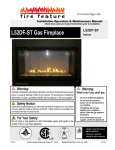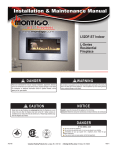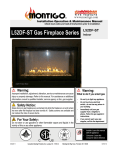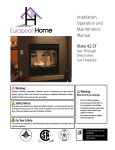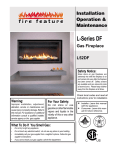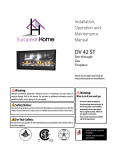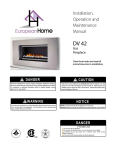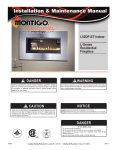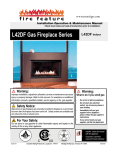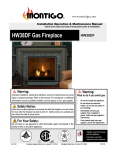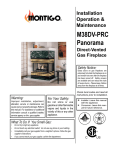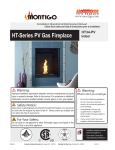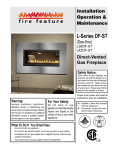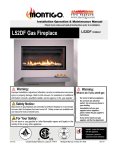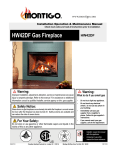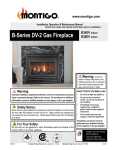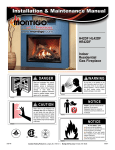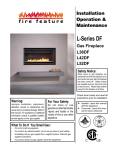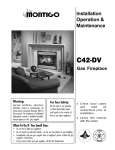Download European Home DV 52 Owner`s manual
Transcript
Installation, Operation and Maintenance Manual DV 52 ST See-through Gas Fireplace Check local codes and read all instructions prior to installation. Warning: Improper installation, adjustment, alteration, service or maintenance can cause injury or property damage. Refer to this manual. For assistance or additional information consult a qualified installer, service agency or the gas supplier. Safety Notice: Glass doors on gas fireplaces are extremely hot while the fireplace is on and remain hot even after the fireplace has been turned off. Safety screens are available and can reduce the risks of severe burns. Please keep children away from the fireplace at all times. Warning: What to do if you smell gas • • • • For Your Safety: Do not try to light any appliance. Do not touch any electrical switch; do not use any phone in your building. Immediately call your gas supplier from a neighbor's phone. Follow the gas supplier's instructions. If you cannot reach your gas supplier, call the fire department. Do not store or use gasoline or other flammable vapors and liquids in the vicinity of this or any other appliance. • ® C US • Installer: Leave this manual with the appliance. Consumer: Leave this manual for future reference. DV 52 ST See-thru Gas Fireplace Warning: Read this manual before installing, operating or troubleshooting this appliance. Please retain this owner's manual for future reference. Congratulations Congratulations on selecting a European Home gas fireplace, an elegant and well-designed gas fireplace built with you in mind. The European Home gas fireplace you have selected is designed to provide the utmost in safety, reliability, and engineering standards. As the owner of this new fireplace, you'll want to read and carefully follow all the instructions contained in this Installation, Operations and Maintenance manual. Pay special attention to all cautions, warnings, and notices. This owner's manual should be retained for future reference. We suggest that you keep it with all your other important documents and product manuals. The information contained in this owner's manual, unless noted otherwise, applies to all models, and gas control systems. Your new European Home gas fireplace will give you years of durable, reliable use. Welcome to the European Home family of gas fireplace products. Safety Alert Key: • DANGER! Indicates a hazardous situation which, if not avoided will result in death or serious injury. • WARNING! Indicates a hazardous situation which, if not avoided could result in death or serious injury. • CAUTION! Indicates a hazardous situation which, if not avoided, could result in minor or moderate injury. • NOTICE: Used to address practices not related to personal injury. • Important: Used to address practices not related to personal injury. Table Of Contents Congratulations Safety Alert Key Introduction................................................................................................ 3 Operation . ......................................................................................... 12 - 15 Installation Maintenance ..................................................................................... 15 - 17 Installing and Framing the Fireplace............................................... 4 Installing the Gas Line..................................................................... 5 Vent Installation.............................................................................. 5 Warranty ................................................................................................... 18 Installation Requirements................................................. 5 Troubleshooting.......................................................................... 16 - 17 Spare Parts.................................................................................... 17 Appendix Installing the Remote Switch..................................................... 5 A. Termination Locations............................................................... 19 Vent Terminations............................................................. 6 B State of Massachusetts/Amendment......................................... 20 Installing the Nailing Flange............................................. 6 Notes Top Vent Runs............................................................................. 7 - 8 Finishing Around the Fireplace Fireplace Facing................................................................ 9 Mantels and Surrounds..................................................... 9 Power Venting............................................................................... 10 Wiring ....................................................................................... 10 Wiring for the Gas Control/Pilot..................................................... 10 Removing and Installing the Door................................................. 11 Page 2 ....................................................................................... 21 rev.110329 DV 52 ST See-thru Gas Fireplace Introduction CAUTION! Due to its high operating temperatures, the appliance should be located out of traffic and away from furniture and draperies. • Children and adults should be alerted to the hazards of the high surface temperature, which could cause burns or clothing ignition. • Young children should be carefully supervised when they are in the same room as the appliance. • Clothing or other flammable materials should not be placed on or near the appliance. About this Fireplace: The DV 52 ST (See-thru) are fireplaces with a linear-style burner. These fireplaces can be converted to either a Top Vent or Rear Vent application. The DV 52 ST (See-thru) is rated for Natural Gas at 40,000 Max. BTU/H (11.73 kW) input and 34,000 Min. BTU/H (9.97 kW) • DV 52 ST; Top Vent, Millivolt Pilot. • DV 52 ST E; Top Vent, Electronic Ignition. This manual covers installation, operation and maintenance. Lighting, operation and care of this fireplace can be easily performed by the homeowner. However, all installation and service work should be performed by a qualified or licensed installer, plumber, or gas fitter who is qualified or licensed by the state, province, region, or governing body in which the appliance is being installed. This manual covers all models and unless otherwise specified, the designation DV 52 ST refers to all variations of the model above. Sections which are specific to a particular symbol, plus the appropriate model number. variation are marked with a Warranty and Installation Information: The European Home warranty will be voided by, and European Home disclaims any responsibility for, the following actions: • Modification of the fireplace and/or components including direct vent assembly or glass doors. • Use of any component part not manufactured or approved by European Home in combination with this European Home fireplace system. • Installation other than as instructed in this manual. Consult your local Gas Inspection Branch on installation requirements for factorybuilt gas fireplaces. Installation and repairs should be done by a qualified contractor. Installations in Canada must conform to the current CAN/CGA B-149.1 and .2 Gas Installation Code and local regulations. If the optional air-circulating fan kit is installed, it must be electrically grounded in accordance with CSA C22.1 Canadian Electrical Code Part 1 and/or local codes. Installations in the USA must conform to local codes, or in the absence of local codes to the National Fuel Gas Code, ANSI Z223.1-1988. If the optional air-circulating fan is installed, it must be grounded in accordance with local codes or, in the absence of local codes, with the National Electrical Code, ANSI/NFPA 70-1987. Within the State of Massachusetts this fireplace must comply with NFPA-54 Chapter 10. rev.110329 What is Combustible? Materials that can catch fire and burn are considered combustible. Any material that is made of, or faced with, wood, wood pulp, paper, plastic or any other material that can catch fire and burn is considered combustible. Even though these materials may have been 'flame-proofed', made 'fire-resistant' or are 'fire-rated' they are considered combustible. The combustibility of a material can be tested per "ASTM E136 Standard Test Method for Behavior of Materials in a Vertical Tube Furnace at 750 Degrees C". Note that 'fireresistant' does NOT mean non-combustible. Note: If a certain material has a core considered to be non-combustible (in accordance with ASTM E136) but is faced with a combustible material then the material is considered to be combustible. When in doubt, ask for an ASTM E136 compliance statement. What is Non-combustible? A given material is said to be non-combustible when it cannot catch fire and burn. For example, materials made entirely, or in combinations, of, stone, brick, concrete, tile, steel, plaster or glass are considered non-combustible. For the purposes of the installations described in this Manual, those materials that have passed the ASTM E136 tests are considered to be non-combustible. As of this writing, the materials listed below are reported by their manufacturers to be non-combustible (in accordance with ASTM E136): • James Hardie Building Products, Inc.: HardieBacker™ 1/4” Cement Board • U.S. Architectural Products, Inc.: Versaroc® Cement Bonded Particle Board Cem-Clad® Cement Panel Page 3 DV 52 ST See-thru Gas Fireplace Installation Installing The Fireplace Shell Framing The fireplace may be installed in any location that maintains proper clearances to air conditioning ducts, electrical wiring and plumbing. Safety, as well as efficiency of operation, must be considered when selecting the fireplace location. Try to select a location that does not interfere with room traffic, has adequate ventilation, and offers an accessible pathway for direct vent installation. Refer to Page 4 - Vent Installation for more information. The fireplace dimensions are shown below: N Both walls Typical. May not be exactly as shown. M 40” O Framing Dimensions (inches) Top View DV 52 ST M N O 39 60 233/4 or 243/4* * When facing with the Overlay Method the depth is increased by 1". See Planning Guide for more information. 6 3/4” B Figure 2. Framing dimensions. E 5 1/4” Side View Front View DV 52 ST A B C D E F G H I J K 52 331/4 47 21/2 211/8 1 24 581/4 12 5 8 Frame the fireplace cavity according to Figure 2. Slide the fireplace into the cavity. Tack four studs (vertical) in place as shown in Figure 2a. Secure the fireplace in position by nailing into these cleats. (Minimum 2" clearance must still be maintained around the vent pipes.) Figure 1. Fireplace dimensions in inches. Clearances These clearances apply to all dimensions except the framed opening, where the clearance to combustibles is 0". The DV 52 ST clearance to unprotected combustible walls which are perpendicular to the fireplace opening, must not project beyond the shaded area shown in Figure 24. Figure 2a. Securing the fireplace to the framing. For protection against freezing temperatures, it is recommended that outer walls of the chase be insulated with a vapor barrier. This will reduce the possibility of a cold-air convection current on the fireplace. WARNING! Clearance to Combustibles Top (Top Vent) 30" Sides 1" Floor 0" Mantel 4" * Clearance from the top of the enclosure. 60” When this appliance is installed directly on carpeting, tile or any combustible material other than wood flooring, it must be installed on a metal or wood panel extending the full width and depth of the appliance. to a combustible ceiling within the ** Refer to page 14. Page 4 rev.110329 DV 52 ST See-thru Gas Fireplace Installation Installing The Gas Line The gas line must be installed before finishing the DV 52 ST Fireplace. Natural Gas requires a minimum inlet gas supply pressure of 5.5" w.c. and a manifold pressure of 3.5" w.c. Propane Gas requires a minimum inlet gas supply pressure of 11" w.c. and a manifold pressure of 10" w.c. Provision must also be made for a 1/8" N.P.T. plugged tapping and be accessible for test gauge connection immediately upstream of the gas supply controls to the appliance. The fireplace gas connection and the main operating gas valve is located behind the removable trim at the bottom of the unit and need only be attached to the gas line with an approved fitting, as required by the applicable installation codes. To access the fireplace gas connection the main burner must be removed as shown below in Figure 5a. • Only use gas shut-off valves approved for use by the state, province, region, or governing body, in which the appliance is being installed, or as required by the applicable installation codes. • Flexible gas connectors must not exceed 3 feet in length, unless it is allowable within applicable installation codes. The appliance and its individual shut-off valve must be disconnected from the gas Vent Installation This section covers the installation of direct venting and terminations. Installation Requirements DV 52 ST fireplaces are certified for use with European Home 5"/8" venting components. Minimum clearance to combustible construction around the vent pipe is 1" on all sides, except on horizontal venting where the top of the pipe must have a clearance of at least 2". • • • Use only certified European Home vent components. (Use of other parts will void the European Home warranty, and may impede the operation of the fireplace.) • All joints must be secured with a minimum of two screws per joint • Vent terminations must not be recessed in walls or siding • Horizontal runs must be supported by a minimum of two supports per horizontal run. A minimum of one screw on each side of support is also required • Flex vent sections may be stretched up to 50% of their total length (e.g. a 24" section may be stretched to 36") • Flex vent sections over 6 feet must fall within the limits set by the venting graph and must have a minimum vertical rise of 3 inches per foot of flex. • Solid vent sections may be cut less than half way from the female end • Venting components can be used in any combination of solid/rigid pipe or flex pipe and in any orientation - male connectors can face in any direction Gasline Access 0.875 dia. 6 2 1/2 Cautions: to center Figure 5a. Gas line access. • supply piping system during any pressure testing of that system at test pressures in excess of 1/2 psig (3.5 kPa). The appliance must be isolated from the gas supply piping system by closing its individual manual shut-off valve during any pressure testing of the gas supply piping system at test pressures equal to or less than 1/2 psig (3.5 kPa). • • • Note: After gas line is connected, each appliance connection, valve and valve train must be checked while under normal operating pressure with either a liquid solution, or leak detection device, to locate any source of leak. Tighten any areas where bubbling appears or leak is detected until bubbling stops completely or leak is no longer detected. DO NOT use a flame of any kind to test for leaks. Vent terminations can be very hot. If the termination is less than 7 feet above a public walkway, it should be fitted with a certified European Home Heat Guard. (Part no. PTKOG). Do not obstruct, or attempt to conceal, the vent termination. These actions will affect the operation of the fireplace, and may be hazardous. In heavy snow areas, take extra care to prevent snow buildup from obstructing the vent termination. Use European Home VSS Vinyl Shield when using on applications with vinyl siding to guard against possible damage. Installing The Remote Switch The DV 52 ST gas valve, located behind the lower horizontal panel, may be connected to a wall switch. The valve generates its own power on a millivolt circuit. Use only low voltage wire, and DO NOT connect any external power to it. Note: The switch location must not exceed 30' from the fireplace. rev.110329 Page 5 DV 52 ST See-thru Gas Fireplace Installation Installing Terminations with Built-In Frames Installing Heat Guards over Terminations 11 PTO-4F (5"/8") 11 PTKOG (5"/8") Figure 5d. Installing a PTO termination heat guard. 1. Ensure that the two long mounting brackets are facing the bottom of the termination. (See inset). This will provide more heat protection at the top of the termination, where temperatures are highest. Figure 5a. Installing a PTO termination. 1. Frame the termination opening to 11" x 11". 2. Fasten the termination to the studs using a minimum of 4 screws. 2. Attach to the faceplate of the termination using four sheet metal screws. 3. If installing the termination over vinyl siding, use the VSS Vinyl Shield. Installing Terminations with MSR Frames 12 MSR 12 PTO-4 (5"/8") Figure 5b. Installing a PTO termination with the MSR frame. Figure 6. Installing the VSS Vinyl Shield. 1. Frame the termination opening to 12" x 12". 2. Fasten the termination to the studs using a minimum of 4 screws. Installing Terminations with MOSR Frames MOSR 12 12 PTO-4 (5"/8") Figure 5c. Installing a PTO termination with the MOSR frame. 1. Frame the termination opening to 12" x 12". 2. Fasten the MOSR frame to the interior side of the studs using a minimum of 4 screws. 3. Insert the termination into the MOSR frame as shown here and attach by screwing through the four pilot holes in the termination. Page 6 rev.110329 DV 52 ST See-thru Gas Fireplace Installation DV 52 ST Top Vent Venting Runs DV 52 ST 1 MIN 1 MIN. Both sides Typical Example A: (Unacceptable Installation) If the vertical dimension from the hearth is 84" and the horizontal run to the wall flange of the vent termination is 36", the installation is NOT acceptable. RHS8 Heat Shield Example B: (Acceptable Installation) If the vertical dimension from the hearth is 108" and the horizontal run to the wall flange of the vent termination is 120", the installation is acceptable. Example C: (Unacceptable Installation) If the vertical dimension from the floor of the fireplace is 72" and the horizontal run to the wall flange of the vent termination is 84", the installation is NOT acceptable. 1 MIN Figure 11. RHS8 Installation. Install by sliding over vent pipe where it passes through the combustible construction. B. Vertical (Through-The-Roof) Installations 120 • Vertical rise >12' can be reduced (on applicable models). • Vertical terminations must be installed: • minimum 2' (two feet) above the highest point where vent passes through the roof. • minimum 6' (six feet) from a mechanical air inlet • minimum 18" (11/2 feet) from a parapet wall. B A C Power venting to be used within the shaded area of graph. Figure 9c. DV 52 ST Top Vent Venting Graph NOTES: All dimension lengths for vertical or horizontal runs are measured from centre of the vent pipe. Venting runs must fall within the limits set by the venting graph (see Figure 9c). RHS8 • Maximum vent height is 32 feet above fireplace. Note that flame characteristics will change if the maximum vent height is used. • Minimum clearances 2" from vent to all combustible materials must be maintained. • A maximum of two offsets (each offset has two 90° bends) may be made and shall not exceed total length of 25% of the vertical vent height, when measured center to center of piping. Example: Typical vent installation. 20' vertical vent 2 - 2' offsets required 25% of 20' = 5' max. offset allowed This venting configuration meets requirements. 5" / 8" Venting A - Termination PVTK-1 B - Flex Sections PFL-1 (12" Section) PFL-2 (24" Section) PFL-3 (36" Section) PFL-4 (48" Section) C - Rigid Sections PEXT-1 (12" m/f Section) PEXT-2 (24" m/f Section) PEXT-3 (36" m/f Section) PEXT-4 (48" m/f Section) D - Support Ring and Plate PSPXT-8 E - Firestop PS-8 F - Roof Flashing PRF-7 (1/12 - 7/12 pt.) PRF-7 (7/12 - 12/12 pt.) Figure 13. Retracted Installation using a combination of solid and flex venting. Use the vent graph to determine your allowable run, then select appropriate components. rev.110329 Page 7 DV 52 ST See-thru Gas Fireplace Installation PEXT 32’ PEXT PXT-10 * For venting minimum 1" clearance to all vertical combustibles, minimum 2" to all horizontal combustibles. Figure 15. Straight, vertical venting showing required PXT-10 adaptor (supplied with the PVTK-1 termination). Figure 17. Vertical venting with 2 offsets (1 offset= two 90° bends). Reduced Vertical Installation (Available on Linear Power Vent models ONLY) It is possible to reduce vertical vent runs from 5"/8" venting to 4"/7" venting. Reduced vertical venting may only be used when the linear (in-line) power vent is required. This is commonly due to longer than normal vent runs or unusually long horizontal vent runs. Figure 16. Vertical venting with 1 offset (1 offset= two 90° bends). NOTES: All dimension lengths for vertical or horizontal runs are measured from centre of the vent pipe. Venting runs must fall within the limits set by the venting graph (see Figure 7b). Figure 18. Reducing Vertical Vent from 5/8" to 4/7". Page 8 rev.110329 DV 52 ST See-thru Gas Fireplace Installation Installing the Horizontal and Vertical Exterior Power Vent A power vent is required where the termination is located too far away from the gas fireplace and/or if the vent run is beyond the scope of this document, or the specifications recommend vent augmentation. These power vents are required for superior venting, safe operation and years of trouble free operation. Mantels and Surrounds NOTE: National Canadian Gas Association mantel test requirements are for fire hazard prevention to combustible materials. New technology, to meet consumer and government demands for the wise use of energy, has prompted us to manufacture many models of fireplaces which are hot, fuel and energy efficient. The available European Home Power Vent models are: Please be aware; temperatures over the mantel will rise above normal room temperature and walls above fireplace may be hot to touch. LDVPV47 - Linear, Interior In-line Power Vent. Warning: EDVPV47 - External Power Vent. When covering the upper metal portion of the fireplace with a non-combustible material Please Note: The decorative facing materials may be subject to temperatures in excess of 250° F. This should be considered when selecting facing materials. We recommend careful consideration be given to the effects of elevated mantel temperatures which may be in excess of product design, for example: candles, plastic or pictures. This can cause melting, deformation, discoloration or premature failure of T.V. and radio components. Finishing Around the Fireplace Combustible mantels and mouldings may be safely installed over the top and on the front of the fireplace provided that they do not project beyond shaded area shown in Figure 24. Side wall clearances are 3". Combustible surrounds may be installed with 3" clearance to the side of the fireplace as shown in Figure 25. Painting: Special care is recommended by the Master Painters and Decorators Association, when painting the fireplace surrounds, to select and apply a quality alkyd sealer prior to the applying of latex paints. This is to prevent leaching of water from evaporation and causing a brownish staining effect to paint over coats. When selecting the finish material for your fireplace, it is important to remember the following: If the surround of the fireplace is to be painted to match the room decor, heat-resistant paint must be provided . Also, decorative facing must not extend past the fireplace opening at all because it will interfere with the access to retainers for removal of glass door and access to the lower compartment. Drywall/ Sheetrock Header 3” Figure 25. Combustible surrounds, (Both Sides Typical). Horizontal Run (in) Figure 24. Combustible mantles and facings. rev.110329 Page 9 DV 52 ST See-thru Gas Fireplace Installation Wiring Gas Control and Pilot Wiring DV 52 ST DV 52 ST Removing and Installing the Doors to thermocouple The doors are removed in a few simple steps. Follow the steps below to remove the horizontal access panel, unlatch the door buckles and remove the door. Replace in reverse order. to thermopile Thermostat Wire (supplied) Figure 26. Wiring the DV 52 ST remote receiver. Step 1: Remove the Horizontal Access Panel Remove the horizontal cover by placing fingers in both finger holes, then pushing away from you and lifting out. Place it aside during maintenance or cleaning. Install in reverse order. Finger Holes Access Panel Figure 28. Removing and Installing the Horizontal Access Panel Step 2: Locate the Door Buckles Figure 28a. Locate the door buckles. (Both Sides Typical) Step 3: Release the Door Buckles Hand-hold Door Latch Slot Door Latch Hook Figure 28b. Door Buckle Tool Step 4: Firmly grasp hand-hold end of door buckle tool and place the machined end in the slot under door frame, as shown. 1 Figure 28c. Page 10 rev.110329 DV 52 ST See-thru Gas Fireplace Installation WARNING! Step 5: Do not attempt to clean glass when hot. Ensure the tool is firmly in the lower end of the slot, as shown, then pull toward you. Caution: hold the tool securely. DV 52 ST Do not clean glass with abrasive materials as any glass etching may cause premature glass failure. 2 Do not operate this fireplace without the glass door, or with a broken glass door. Figure 28d. Step 6: Pull hard if necessary to release the spring tension. Caution: The latch springs back with force, hold the tool securely. 3 Figure 28e. Installing the Glass Beads and DV 52 ST Optional Fire Media Step 7: Remove the tool from the latch slot. Ensure the latches are hanging freely, the hook end is released from the bottom of the door. Repeat all four steps for the remaining latches. The DV 52 ST fireplace is supplied with glass beads. Optional stone and driftwood fire media are available. 4 Figure 28f. Step 8: Remove the door and trim as shown previously. Follow these instructions to ensure all parts are removed or replaced as required. Once the trim and glass doors are removed place the glass beads AROUND the burner. The glass beads may be placed on the mesh pilot flame cover but neither the glass beads nor the fire media may be placed on the burner itself (see Figure 29, below.) Removing the Door Grasp the door on either side, usually midway and lift upward, lift the door carefully up and away from the front of the fireplace. See Figure 28g. Place the door aside in a safe place while maintenance and/or cleaning is being performed. Figure 29. Installation with glass beads . Figure 28g. Removing and installing the glass doors. (Both Sides Typical) Installing the Door To install the door, hook the top edge of the door frame into place. Lower the door into position and follow the previous steps shown in reverse order. rev.110329 Page 11 DV 52 ST See-thru Gas Fireplace Operation - Model DV 52 ST DV 52 ST with Continuous Pilot For Your Safety - READ BEFORE LIGHTING: WARNING: If you do not follow these instructions exactly, a fire or explosion may result causing property damage, personal injury or loss of life. A. This appliance has a pilot which must be lighted by hand. When lighting the pilot, follow these instructions exactly. B. BEFORE LIGHTING smell all around the appliance area for gas. Be sure to smell next to the floor because some gas is heavier than air and will settle on the floor. What To Do If You Smell Gas: Do not try to light any appliance. • Do not touch any electrical switch; do not use any phone in your building. • Immediately call your gas supplier from a neighbor's phone. Follow the gas supplier's instructions. • • If you cannot reach your gas supplier, call the Fire Department. C. Use only your hand to push in or turn the gas control knob. Never use tools. If the knob will not push in or turn by hand, don't try to repair it, call a qualified service technician. Force or attempt to repair may result in a fire or explosion. D. Do not use this appliance if any part has been under water. Immediately call a qualified service technician to inspect the appliance and to replace any part of the control system, and any gas control which has been under water. Lighting Instructions: 1. 2. 3. 4. STOP! Read the safety information above on this label. Lift out the lower horizontal access panel. to "OFF." Push in gas control knob and turn clockwise Wait five (5) minutes to clear out any gas. Smell for gas, including near the floor. If you then smell gas, STOP! Follow "B" in the safety information above on this label. If you don't smell gas, go to the next step. 5. Locate pilot burner, see illustration at right, and follow steps below. to "PILOT." 6. Turn knob on gas control counter clockwise 7. Push in gas control knob completely and hold. Light with Piezo Igniter button. Continue to hold the control knob in for about (1) minute after the pilot is lit. Release the knob and it will pop back up. Pilot should remain NOTE: lit. If it goes out repeat steps 3 through 8. • If knob does not pop up when released. Stop and immediately call your service technician or gas supplier. • If the pilot will not stay lit after several tries, turn the gas control knob to "OFF" and call your service technician or gas supplier. to "ON." 8. Push in gas control knob and turn counter-clockwise 9. Replace the lower horizontal access panel. 10. Turn on remote switch to ignite fire. Gas control knob cannot be turned from "PILOT" to "OFF" unless knob is pushed in slightly. Do not force. To Turn Off Gas To Appliance: 1. Turn off remote switch. 2. Lift out the lower horizontal access panel. 3. Push in gas control knob slightly and turn not force. clockwise to "Off". Do 4. Replace the lower horizontal access panel. Page 12 rev.110329 DV 52 ST See-thru Gas Fireplace DVB-Series 52 ST E Operation - Model DV 52 ST E with Proflame SIT Electronic Ignition For Your Safety - READ BEFOREIgnition LIGHTING: American Flame Electronic WARNING: If you do not follow these instructions exactly, a fire or explosion may result causing property damage, personal injury or loss of life. A. This appliance is equipped with an ignition system that lights the pilot burner automatically. Do not attempt to light the pilot by hand. B. BEFORE LIGHTING smell all around the appliance area for gas. Be sure to smell next to the floor because some gas is heavier than air and will settle on the floor. What To Do If You Smell Gas: • Do not try to light any appliance. • Do not touch any electrical switch; do not use any phone in your building. • Immediately call your gas supplier from a neighbor's phone. Follow the gas supplier's instructions. • If you cannot reach your gas supplier, call the Fire Department. tools. If the knob will not push in or turn by hand, don't try to repair it, call a qualified service technician. Force or attempt to repair may result in a fire or explosion. D. Do not use this appliance if any part has been under water. Immediately call a qualified service technician to inspect the appliance and to replace any part of the control system, and any gas control which has been under water. C. Use only your hand to push in or turn the gas control knob. Never use Lighting Instructions: 1. STOP! Read the safety information above on this label. 2. Remove the lower horizontal access panel. 3. Turn Incoming gas valve to the ON" position. 4. Wait 5 minutes to clear out any gas. If you smell gas, STOP! Follow "B" in the safety information above on this label. If you don't smell gas, go to the next step. 5. Turn wall switch "ON". (one minute audible clicking, thirty seconds of silence, and then another one minute of audible clicking). If the system locks out due to inadequate gas flow, refer to "Troubleshooting Section". 7. After completion of the information in the Troubleshooting section, Repeat step 5. 8. If the system will not function correctly, follow the instructions "To Turn Off Gas To Appliance" and call your service technician or gas supplier. 6. If the fireplace does not light, the system will cycle through two trials, EV1 (pilot burner) Pilot Sensor Lockout Reset Key EV2 (main burner) Pilot Adjust Screw Diagnostic Terminal Gas "In" Igniter Ground EV1 (pilot burner) EV2 (main burner) Power Command (Wall switch) Incoming Gas Line, Shut-off Valve Gas "Out" To fireplace main burner To Turn Off Gas To Appliance: 1. Turn off remote switch. 3. Turn the incoming gas control valve to "Off". 2. Remove the lower horizontal access panel. 4. Replace the lower horizontal access panel. rev.110329 Page 13 DV 52 ST See-thru Gas Fireplace Operation Maintenance Lighting Instructions General See pages 12 to 13. Have the fireplace and installation inspected yearly. The inspection must include, but is not limited to, the following: • Burner Adjustment • A visual check of the entire vent system and termination. The DV 52 ST is equipped with an adjustable burner, allowing you to raise or lower the flames. To adjust the flames, locate the black knob marked 'Hi-Lo', in the centre of the gas control valve (See Figure 32). The front burners are not adjustable. • An inspection of the explosion relief flappers and the door gasketing to ensure a proper seal. • To raise the flame height, turn the black knob (located behind the lower trim) counter-clockwise. • To lower the flame height, turn clockwise. • An inspection of the gas valve, gas components, and pilot flame. For your convenience a 1/8" manifold pressure tap is supplied on the gas valve for a test gauge connection. See Figure 32. • An inspection of the burner, venturi, and primary air openings. • Inspection of all optional equipment, thermostats, etc. 'Hi-Lo' Adjustment Knob Figure 32. 'Hi-Lo' Adjustment on the DV 52 ST gas valve. • For Natural Gas this appliance requires a minimum inlet pressure of 5.5" W.C. and a manifold pressure of 3.5" W.C. • For Propane Gas this appliance requires a minimum inlet pressure of 11" W.C. and a manifold pressure of 10" W.C. • Always keep the fireplace area clear and free of combustible materials, as well as gasoline and other flammable vapors and liquids. • Do not use this appliance if any part has been under water. Immediately call a qualified service technician to inspect the appliance and to replace any part of the control system and any gas control which has been under water. Cleaning When the fireplace is first activated, there may be some smoking and a visible film may be left on the glass. This is a normal condition, and is the result of burning of protective coatings on new metal. • Glass must be cleaned periodically to remove any film (which is a normal byproduct of combustion) which may be visible. Film can easily be removed by removing the door, as shown on page 12. Handle the door carefully, and clean it with non-abrasive glass cleaners. One of the most effective products is Kel Kem. • Silicone seals on inner door during initial firing will "off gas", leaving a visual deposit of a white substance on combustion chamber walls. This can easily be removed using normal household products. • Fireplace gas control must be in the “OFF” position and pilot and main burners extinguished when cleaning appliance with a vacuum. • Use a vacuum cleaner or whisk broom to keep the control compartment, burner, and firebox free from dust and lint. • Doors can get very hot. Handle only when cool. • Linear burners may be cleaned periodically with a vacuum to remove soot or other contaminates. CAUTION! WARNING! Do not attempt to clean glass when hot. Do not clean glass with abrasive materials as any glass etching may cause premature glass failure. Page 14 rev.110329 DV 52 ST See-thru Gas Fireplace Maintenance Gas Control Valve Troubleshooting Power Generator Pilot Adjustment Screw The following is a troubleshooting chart of possible problems: PROBLEM Manifold Pressure Test Connection Figure 33. Sit Nova 820 gas valve. CORRECTIVE ACTION Noisy pilot flame Locate pilot adjustment screw on gas control valve. Flame is decreased by turning adjustment screw clockwise. Pilot won’t ignite Disconnect remote wires and try to light pilot. If pilot now works, remote connections are faulty. Check wiring diagram Figure 33. Main burner will not light 1. Check wiring, see Figure 33. 2. Check wall switch for proper connection. Wall Switch Inlet Pressure DV 52 ST Pilot Burner Adjustment 1. Locate Pilot Adjustment Screw. See Figure 33. 2. Adjust pilot screw to provide properly sized flame as shown in Figure 34. 3. After installing or servicing, leak test with a soap solution with main burner on. Coat pipe and tubing joints, gasket etc. with soap solution. Bubbles indicate leaks. Tighten any areas where the bubbles appear until the bubbling stops completely. If your fireplace still does not operate correctly, consult your dealer or the manufacturer. All service and repairs should be performed by a qualified agency. All spare parts, optional trim finishes are available from your local dealer or the manufacturer. Figure 34. Pilot Burner. rev.110329 Page 15 DV 52 ST See-thru Gas Fireplace Maintenance Troubleshooting DV 52 ST E To reset the SIT System, refer to schematic, below and: 1 1. Locate the connection to the battery backup and disconnect it. 2. Locate the AC/DC wall transformer and unplug the connector. Wait for 120 seconds and re-connect the wall transformer and battery backup. If your fireplace still does not operate correctly, consult your installer. 2 DV 52 ST Spare Parts NG Gas Valve LP Gas Valve NG Pilot LP Pilot NG Burner LP Burner NG Orifice LP Orifice Door Base DV 52 ST RGC1006 RGC1005 RPA020 RPA021 RBLS201 RBLS202 Side: 2@51 DMS Center: 2@52 DMS 4@62 DMS RDTL52 RLGS54 DV 52 ST E RGC3033 RGC3034 RPA052 RPA053 ROR RDTL52 RLGS54 1. 2. Page 16 rev.110329 DV 52 ST See-thru Gas Fireplace Warranty The Warranty The Company warrants the European Home Gas Appliance to be free from defects in materials and workmanship at the time of manufacture. On the European Home Gas Appliance, there is a ten-year warranty on the firebox and its components, a five-year warranty on the main burner and pilot burner, and a one-year warranty on the gas control valve and fibre logs. Glass, plated/ painted finishes, and refractory lining are exempt. Remedy And Exclusions The coverage of this Warranty is limited to all components of the Gas Appliance manufactured by The Company. This Warranty only covers European Home Gas Appliances installed in the United States or Canada. If the components of the Gas Appliance covered by this Warranty are found to be defective within the time frame stated (see The Company's right of investigation outlined below). The Company will, at its option, replace or repair defective components of the Gas Appliance manufactured by The Company at no charge, and will also pay for reasonable labor costs incurred in replacing or repairing components. If repair or replacement is not commercially practical, The Company will, at its option, refund the purchase price of the European Home Gas Appliance. This Warranty covers only parts and labor as provided above. In no case shall The Company be responsible for materials, components, or construction which are not manufactured or supplied by The Company, or for the labor necessary to install, repair or remove such materials, components or construction. All replacement or repair components will be shipped F.O.B. the nearest Company factory. Qualifications To The Warranty The Gas Appliance Warranty outlined above is further subject to the following qualifications: (1) The Gas Appliance must be installed in accordance with The Company installation instructions and local building codes. The Warranty on this European Home Gas Appliance covers only the component parts manufactured by The Company. The use of components manufactured by others with this European Home Gas Appliance could create serious safety hazards, may result in the denial of certification by recognized national safety agencies, and could be in violation of local building codes. This warranty does not cover any damages occurring from the use of any components not manufactured or supplied by The Company (2) The European Home Gas Appliance must be subjected to normal use. The Gas Appliances are designed to burn gas only. Burning conventional fireplace fuels such as wood, coal or any other solid fuel will cause damage to the Gas Appliance, will produce excessive temperatures and will result in a fire hazard. Limitations On Liability It is expressly agreed and understood that The Company sole obligation, and purchaser's exclusive remedy under this Warranty, under any other warranty, expressed or implied, or in contract, tort or otherwise, shall be limited to replacement, repair, or refund, as specified above. In no event shall The Company be responsible for any incidental or consequential damages caused by defects in its products, whether such damage occurs or is discovered before or after replacement or repair, and whether or not such damage is caused by Company negligence. Some states do not allow the exclusion or limitation of incidental or consequential damages, so the above limitation or exclusion may not apply to you. The duration of any implied warranty with respect to this European Home Gas Appliance is limited to the duration of the foregoing warranty. Some states do not allow limitation on how long an implied warranty lasts, so the above may not apply to you. Investigation Of Claims Against Warranty The Company reserves the right to investigate any and all claims against this Warranty and to decide upon method of settlement. The Company Is Not Responsible For Work Done Without Written Consent The Company shall in no event be responsible for any warranty work done without first obtaining The Company's written consent. Dealers Have No Authority To Alter This Warranty The Company employees and dealers have no authority to make any warranties nor to authorize any remedies in addition to or inconsistent with those stated above. How To Register A Claim Against Warranty In order for any claim under this Warranty to be valid, The Company must be notified of the claimed defect in writing or by telephone, as soon as reasonably possible after the defect is discovered. Claims against this Warranty in writing should include the date of installation, and a description of the defect. Other Rights This Warranty gives you specific legal rights, and you may also have other rights which vary from state to state. NOTE: The Company, as stated above, refers to European Home, a division of Europa Ja, Inc. The Company reserves the right to make changes at any time, without notice, in design, materials, specifications, prices and also to discontinue colors, styles and products. rev.110329 Page 17 DV 52 ST See-thru Gas Fireplace Appendix A - Termination Locations A = clearance to the termination frame above grade, veranda, porch, deck, or balcony [16 inches (41 cm) minimum] B = clearance to door, or sides and top of window, that may be opened [16 inches (41 cm) minimum for appliances ≤100 000 BTU/H (30kW)] C = clearance to bottom of window that may be opened horizontally [36 inches (92 cm) minimum for appliances ≤100 000 BTU/H (30kW)] (2.1 m) minimum] P = clearance under veranda, porch, deck, or balcony [16 inches (41 cm) minimum‡ to non-combustibles][22 inches (56 cm) minimum‡ to combustibles] Q = clearance above a roof [24 inches (61 cm) minimum] R = clearance to adjacent walls and neighboring buildings [18 inches (46 cm) minimum] D = no clearance to permanently closed window when installed with approved glass penetration termination S = clearance from corner in recessed location [12 inches (31 cm) minimum] E = clearance to permanently closed window [16 inches 41 cm recommended to prevent condensation on window] U = minimum width for back wall of recessed location [24 inches (61 cm) minimum] F = vertical clearance to ventilated soffit located above the termination within a horizontal distance of 2 feet (61 cm) from the centerline of the termination [22 inches (56 cm) minimum] W = horizontal clearance between the frames of two terminations that are not level. [36 inches (92 cm) minimum] G = clearance to unventilated soffit [16 inches (41 cm) minimum to non-combustibles] [22 inches (56 cm) minimum to combustibles] H = clearance to outside corner [9 inches (23 cm) minimum] I = clearance to inside corner [12 inches (31 cm) minimum] J = * not to b e installed ab ove a meter/regula tor a ssembly within 40" (103 cm) horizontally from the centerline of the regulator T = maximum depth in recessed location [48 inches (122 cm) minimum] V = no horizontal clearance between the frames of two terminations that are level. a vent shall not terminate directly above a sidewalk or paved driveway which is located between two single family dwellings and serves both dwellings only permitted if veranda, porch, deck, or balcony has an open side that is equal to or greater than the depth of the enclosed area * as specified in CGA B149 Installation Codes. Note: local codes or regulations may require different clearance. † ‡ K = clearance to service regulator vent outlet [3 feet minimum in the United States] [*6 feet (1.8 m) minimum in Canada] L = clearance to non-mechanical air supply inlet to building or the combustion air inlet to any other appliance [16 inches (41 cm) minimum for appliances ≤100 000 BTU/H (30kW)] M = clearance to mechanical air supply inlet [*6 feet (1.8 m) minimum] N = † clearance above paved sidewalk or a paved driveway located on public property [*7 feet Page 18 rev.110329 DV 52 ST See-thru Gas Fireplace Appendix B - State of Massachusetts Amendment (Gas Fireplace / Equipment sold in the State of Massachusetts) 5.08: Modifications to NFPA-54, Chapter 10 (1) Revise NFPA-54 section 10.5.4.2 by adding a second exception as follows: Existing chimneys shall be permitted to have their use continued when a gas conversion burner is installed, and shall be equipped with a manually reset device that will automatically shut off the gas to the burner in the event of a sustained back-draft. (2) Revise 10.8.3 by adding the following additional requirements: (a) For all side wall horizontally vented gas fueled equipment installed in every dwelling, building or structure used in whole or in part for residential purposes, including those owned or operated by the Commonwealth and where the side wall exhaust vent termination is less than seven (7) feet above finished grade in the area of the venting, including but not limited to decks and porches, the following requirements shall be satisfied: 1. INSTALLATION OF CARBON MONOXIDE DETECTORS. At the time of installation of the side wall horizontal vented gas fueled equipment, the installing plumber or gas fitter shall observe that a hard wired carbon monoxide detector with an alarm and battery back-up is installed on the floor level where the gas equipment is to be installed. In addition, the installing plumber or gas fitter shall observe that a battery operated or hard wired carbon monoxide detector with an alarm is installed on each additional level of the dwelling, building or structure served by the side wall horizontal vented gas fueled equipment. It shall be the responsibility of the property owner to secure the services of qualified licensed professionals for the installation of hard wired carbon monoxide detectors a. In the event that the side wall horizontally vented gas fueled equipment is installed in a crawl space or an attic, the hard wired carbon monoxide detector with alarm and battery back-up may be installed on the next adjacent floor level. b. In the event that the requirements of this subdivision can not be met at the time of completion of installation, the owner shall have a period of thirty (30) days to comply with the above requirements; provided, however, that during said thirty (30) day period, a battery operated carbon monoxide detector with an alarm shall be installed. 2. APPROVED CARBON MONOXIDE DETECTORS. Each carbon monoxide detector as required in accordance with the above provisions shall comply with NFPA 720 and be ANSI/UL 2034 listed and IAS certified. 3. SIGNAGE. A metal or plastic identification plate shall be permanently mounted to the exterior of the building at a minimum height of eight (8) feet above grade directly in line with the exhaust vent terminal for the horizontally vented gas fueled heating appliance or equipment. The sign shall read, in print size no less than one-half (1/2) inch in size, “GAS VENT DIRECTLY BELOW. KEEP CLEAR OF ALL OBSTRUCTIONS”. 4. INSPECTION. The state or local gas inspector of the side wall horizontally vented gas fueled equipment shall not approve the installation unless, upon inspection, the inspector observes carbon monoxide detectors and signage installed in accordance with the provisions of 248 CMR 5.08(2)(a)1 through 4. (b) EXEMPTIONS: The following equipment is exempt from 248 CMR 5.08(2)(a)1 through 4: 1. The equipment listed in Chapter 10 entitled “Equipment Not Required To Be Vented” in the most current edition of NFPA 54 as adopted by the Board; and 2. Product Approved side wall horizontally vented gas fueled equipment installed in a room or structure separate from the dwelling, building or structure used in whole or in part for residential purposes. (c) MANUFACTURER REQUIREMENTS - GAS EQUIPMENT VENTING SYSTEM PROVIDED. When the manufacturer of Product Approved side wall horizontally vented gas equipment provides a venting system design or venting system components with the equipment, the instructions provided by the manufacturer for installation of the equipment and the venting system shall include: 1. Detailed instructions for the installation of the venting system design or the venting system components; and 2. A complete parts list for the venting system design or venting system. (d) MANUFACTURER REQUIREMENTS - GAS EQUIPMENT VENTING SYSTEM NOT PROVIDED. When the manufacturer of a Product Approved side wall horizontally vented gas fueled equipment does not provide the parts for venting the flue gases, but identifies “special venting systems”, the following requirements shall be satisfied by the manufacturer: 1. The referenced “special venting system” instructions shall be included with the appliance or equipment installation instructions; and 2. The “special venting systems” shall be Product Approved by the Board, and the instructions for that system shall include a parts list and detailed installation instructions. (e) A copy of all installation instructions for all Product Approved side wall horizontally vented gas fueled equipment, all venting instructions, all parts lists for venting instructions, and/or all venting design instructions shall remain with the appliance or equipment at the completion of the installation. (3) After NFPA-54 section 10.10.4.2 add a new section 10.10.4.3 as follows: When more than four gas appliances are to be vented through a common gas vent or common horizontal vent manifold, a plan of the proposed vent installation shall be submitted to the Inspector and the serving gas supplier for review and approval. Extraction from: Massachusetts Rules and Regulations 5.00: Amendments To 2002 Edition Of ANSI Z223.1-NFPA-54 rev.110329 Page 19 EUROPEAN HOME a division of Europa Ja, Inc. 376 Washington St. Suite 203 Malden, MA 02148 tel: 781/324-8383 fax: 781/324-8384 www.europeanhome.com




















